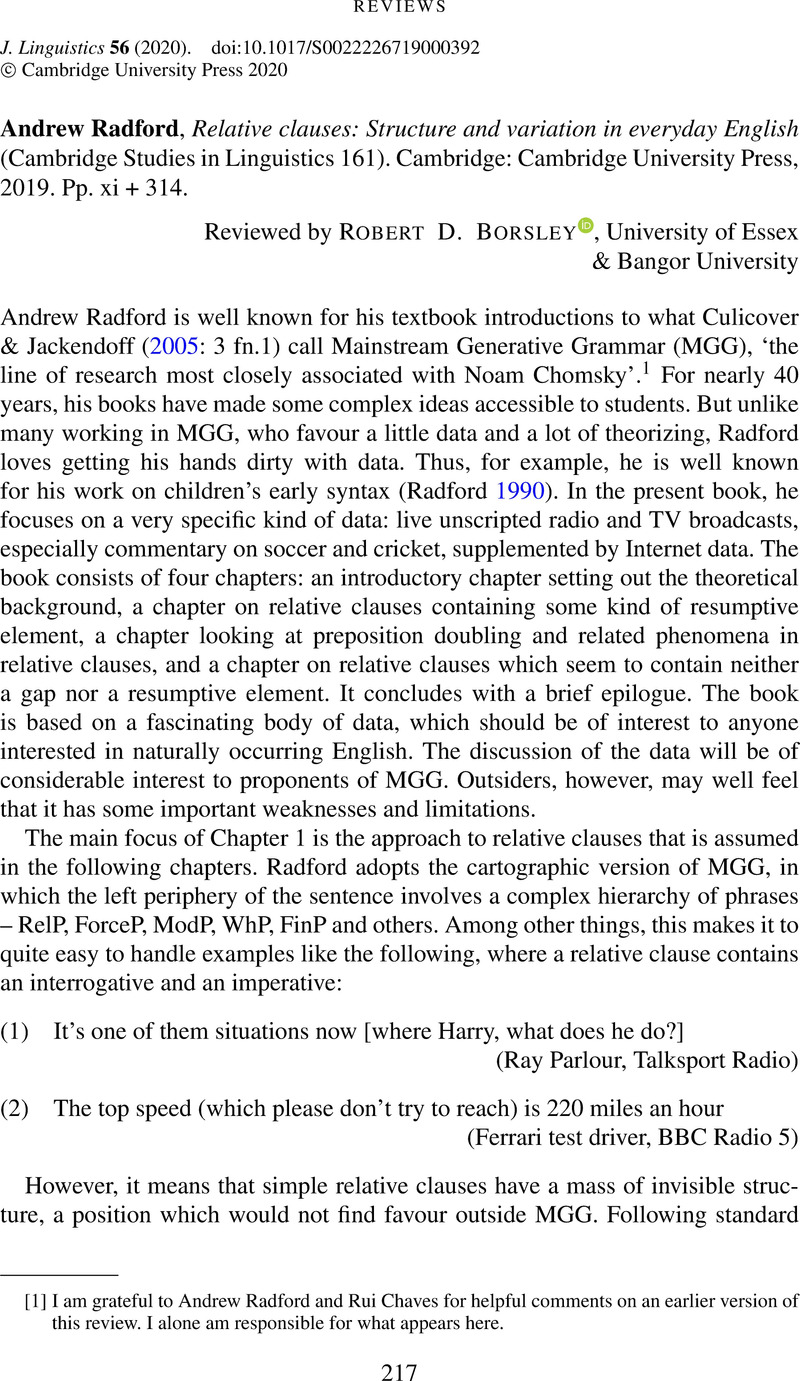No CrossRef data available.
Article contents
Andrew Radford, Relative clauses: Structure and variation in everyday English (Cambridge Studies in Linguistics 161). Cambridge: Cambridge University Press, 2019. Pp. xi + 314.
Published online by Cambridge University Press: 31 January 2020
Abstract
An abstract is not available for this content so a preview has been provided. Please use the Get access link above for information on how to access this content.

- Type
- Reviews
- Information
- Copyright
- Copyright © Cambridge University Press 2020
References
Alotaibi, Mansour & Borsley, Robert D.. 2013. Gaps and resumptive pronouns in Modern Standard Arabic. In Müller, Stefan (ed.), Proceedings of the 20th International Conference on Head-driven Phrase Structure Grammar, 6–26. Stanford, CA: CSLI Publications.Google Scholar
Aoun, Joseph, Choueiri, Lina & Hornstein, Norbert. 2001. Resumption, movement, and derivational economy. Linguistic Inquiry
32, 371–403.Google Scholar
Borsley, Robert D.
2013. On the nature of Welsh unbounded dependencies. Lingua
133, 1–29.Google Scholar
Culicover, Peter W. & Jackendoff, Ray. 2005. Simpler syntax. Oxford: Oxford University Press.Google Scholar
Henderson, John M. & Ferreira, Fernanda. 1990. Effects of foveal processing difficulty on the perceptual span in reading: Implications for attention and eye movement control. Journal of Experimental Psychology: Learning, Memory, & Cognition
16, 417–429.Google Scholar
Huddleston, Rodney D. & Pullum, Geoffrey K.
et al.
2002. The Cambridge grammar of the English language. Cambridge: Cambridge University Press.Google Scholar
Pollard, Carl & Sag, Ivan A.. 1992. Anaphors in English and the scope of binding theory. Linguistic Inquiry
23, 261–303.Google Scholar
Radford, Andrew. 1990. Syntactic theory and the acquisition of English syntax: The nature of early child grammars of English. Oxford: Basil Blackwell.Google Scholar
Radford, Andrew, Felser, Claudia & Boxell, Oliver. 2012. Preposition copying and pruning in present-day English. English Language and Linguistics
16, 403–426.Google Scholar
Rayner, Keith & Duffy, Susan A.. 1986. Lexical complexity and fixation times in reading: Effects of word frequency, verb complexity, and lexical ambiguity. Memory & Cognition
14, 191–201.Google Scholar
Rayner, Keith & Pollatsek, Alexander. 1987. Eye movements in reading: A tutorial review. In Coltheart, Max (ed.), Attention and performance XII: The psychology of reading
(Psychology Library Editions: Cognitive Science), 327–362. London: Erlbaum.Google Scholar
Sag, Ivan A.
1997. English relative clause constructions. Journal of Linguistics
33, 431–484.Google Scholar
Willis, David W. E.
2011. The limits of resumption in Welsh wh-dependencies. In Rouveret, Alain (ed.), Resumptive pronouns at the interfaces, 189–222. Amsterdam: John Benjamins.Google Scholar





